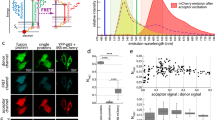Abstract
The import of many peroxisomal matrix proteins is initiated by the interaction of type-1 peroxisomal targeting signals (PTS1) residing at the extreme C-terminus of cargo proteins and their receptor protein PEX5. This interaction has been amply investigated by biophysical methods using isolated proteins and peptides or heterologous systems such as two-hybrid assays. However, a recently developed novel application of Fluorescence resonance energy transfer (FRET) allows a quantifying measurement of this interaction in living cells. This method combines the systematic measurement of FRET-efficiency in a high number of cells with a well-suited normalization protocol and a fitting algorithm, which together allow the estimation of numerical values for the apparent interaction strength that correlates with other measures of binding strength but can be obtained under rather physiological conditions.
Access this chapter
Tax calculation will be finalised at checkout
Purchases are for personal use only
Similar content being viewed by others
References
Brocard C, Hartig A (2006) Peroxisome targeting signal 1: is it really a simple tripeptide? Biochim Biophys Acta 1763(12):1565–1573. https://doi.org/10.1016/j.bbamcr.2006.08.022
Kunze M (2020) The type-2 peroxisomal targeting signal. Biochim Biophys Acta, Mol Cell Res 1867(2):118609. https://doi.org/10.1016/j.bbamcr.2019.118609
Neuberger G, Maurer-Stroh S, Eisenhaber B, Hartig A, Eisenhaber F (2003) Prediction of peroxisomal targeting signal 1 containing proteins from amino acid sequence. J Mol Biol 328(3):581–592. https://doi.org/10.1016/s0022-2836(03)00319-x
Reumann S (2004) Specification of the peroxisome targeting signals type 1 and type 2 of plant peroxisomes by bioinformatics analyses. Plant Physiol 135(2):783–800. https://doi.org/10.1104/pp.103.035584
Notzel C, Lingner T, Klingenberg H, Thoms S (2016) Identification of new fungal peroxisomal matrix proteins and revision of the PTS1 consensus. Traffic 17(10):1110–1124. https://doi.org/10.1111/tra.12426
Gould SJ, Keller GA, Hosken N, Wilkinson J, Subramani S (1989) A conserved tripeptide sorts proteins to peroxisomes. J Cell Biol 108(5):1657–1664. https://doi.org/10.1083/jcb.108.5.1657
Cross LL, Paudyal R, Kamisugi Y, Berry A, Cuming AC, Baker A, Warriner SL (2017) Towards designer organelles by subverting the peroxisomal import pathway. Nat Commun 8(1):454. https://doi.org/10.1038/s41467-017-00487-7
Lametschwandtner G, Brocard C, Fransen M, Van Veldhoven P, Berger J, Hartig A (1998) The difference in recognition of terminal tripeptides as peroxisomal targeting signal 1 between yeast and human is due to different affinities of their receptor Pex5p to the cognate signal and to residues adjacent to it. J Biol Chem 273(50):33635–33643. https://doi.org/10.1074/jbc.273.50.33635
Kunze M (2018) Predicting peroxisomal targeting signals to elucidate the peroxisomal proteome of mammals. Subcell Biochem 89:157–199. https://doi.org/10.1007/978-981-13-2233-4_7
Ghosh D, Berg JM (2010) A proteome-wide perspective on peroxisome targeting signal 1(PTS1)-Pex5p affinities. J Am Chem Soc 132(11):3973–3979. https://doi.org/10.1021/ja9109049
Hochreiter B, Chong C-S, Hartig A, Maurer-Stroh S, Berger J, Schmid JA, Kunze M (2020) A novel FRET approach quantifies the interaction strength of peroxisomal targeting signals and their receptor in living cells. Cell 9(11):2381
Bunt G, Wouters FS (2017) FRET from single to multiplexed signaling events. Biophys Rev 9(2):119–129. https://doi.org/10.1007/s12551-017-0252-z
Hochreiter B, Garcia AP, Schmid JA (2015) Fluorescent proteins as genetically encoded FRET biosensors in life sciences. Sensors (Basel) 15(10):26281–26314. https://doi.org/10.3390/s151026281
Okamoto K, Sako Y (2017) Recent advances in FRET for the study of protein interactions and dynamics. Curr Opin Struct Biol 46:16–23. https://doi.org/10.1016/j.sbi.2017.03.010
Hochreiter B, Kunze M, Moser B, Schmid JA (2019) Advanced FRET normalization allows quantitative analysis of protein interactions including stoichiometries and relative affinities in living cells. J Sci Rep 9(8233):1–16. https://doi.org/10.1038/s41598-019-44650-0
Baes M, Gressens P, Baumgart E, Carmeliet P, Casteels M, Fransen M, Evrard P, Fahimi D, Declercq PE, Collen D, van Veldhoven PP, Mannaerts GP (1997) A mouse model for Zellweger syndrome. Nat Genet 17(1):49–57. https://doi.org/10.1038/ng0997-49
Nagy P, Bene L, Hyun WC, Vereb G, Braun M, Antz C, Paysan J, Damjanovich S, Park JW, Szollosi J (2005) Novel calibration method for flow cytometric fluorescence resonance energy transfer measurements between visible fluorescent proteins. Cytometry A 67(2):86–96. https://doi.org/10.1002/cyto.a.20164
Chong CS, Kunze M, Hochreiter B, Krenn M, Berger J, Maurer-Stroh S (2019) Rare human missense variants can affect the function of disease-relevant proteins by loss and gain of peroxisomal targeting motifs. Int J Mol Sci 20(18). https://doi.org/10.3390/ijms20184609
Bajar BT, Wang ES, Zhang S, Lin MZ, Chu J (2016) A guide to fluorescent protein FRET pairs. Sensors (Basel) 16(9). https://doi.org/10.3390/s16091488
Malkani N, Schmid JA (2011) Some secrets of fluorescent proteins: distinct bleaching in various mounting fluids and photoactivation of cyan fluorescent proteins at YFP-excitation. PLoS One 6(4):e18586. https://doi.org/10.1371/journal.pone.0018586
Youvan DC, Silva CM, Bylina EJ, Coleman WJ, Dilworth MR, Yang MM (1997) Calibration of fluorescence resonance energy transfer in microscopy using genetically engineered GFP derivates on nickel chelating beads. Biotechnology 3:1–18
Author information
Authors and Affiliations
Corresponding authors
Editor information
Editors and Affiliations
Rights and permissions
Copyright information
© 2023 The Author(s), under exclusive license to Springer Science+Business Media, LLC, part of Springer Nature
About this protocol
Cite this protocol
Hochreiter, B., Schmid, J.A., Berger, J., Kunze, M. (2023). Estimating the Interaction Strength Between PTS1-Peptides and Their Receptor PEX5 in Living Cells Using Flow-Cytometer-Based FRET (flowFRET) Measurements. In: Schrader, M. (eds) Peroxisomes. Methods in Molecular Biology, vol 2643. Humana, New York, NY. https://doi.org/10.1007/978-1-0716-3048-8_30
Download citation
DOI: https://doi.org/10.1007/978-1-0716-3048-8_30
Published:
Publisher Name: Humana, New York, NY
Print ISBN: 978-1-0716-3047-1
Online ISBN: 978-1-0716-3048-8
eBook Packages: Springer Protocols




